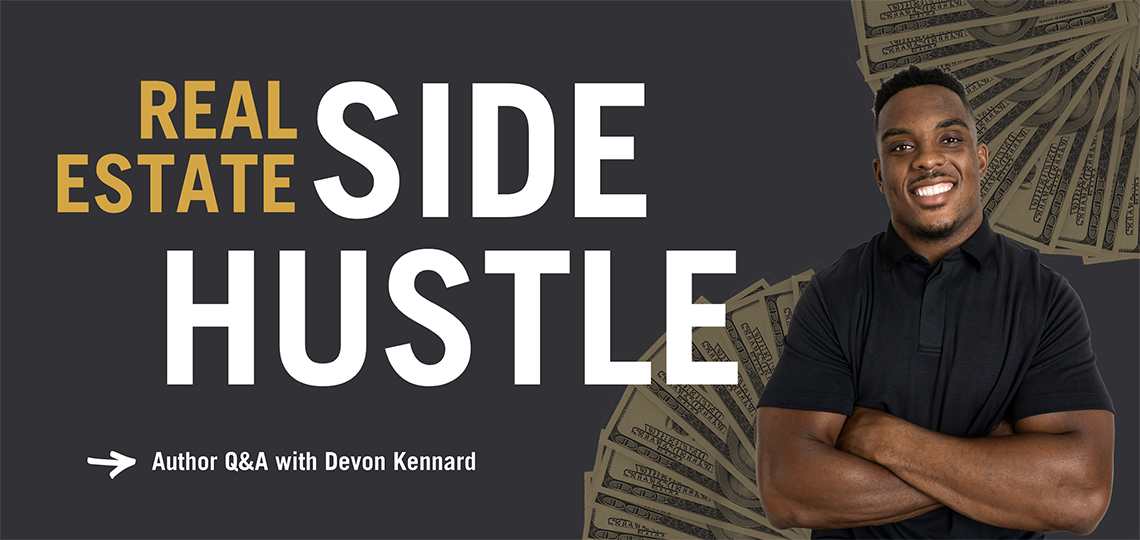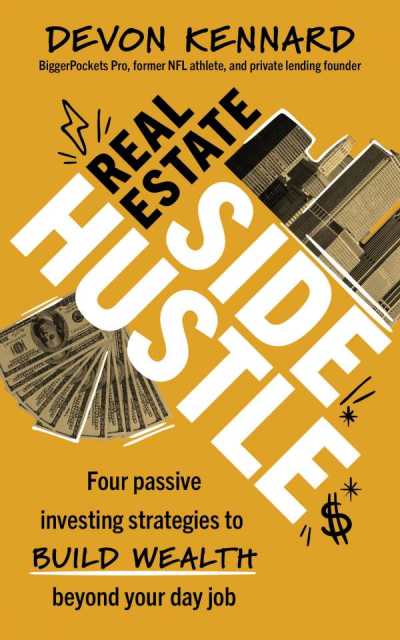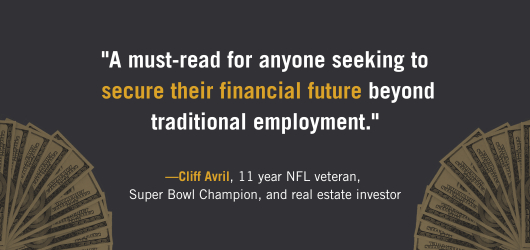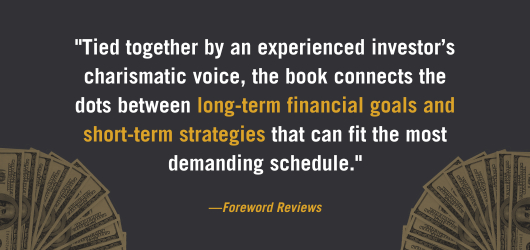Build wealth beyond your day job: a Q&A with NFL pro Devon Kennard

A Conversation with Devon Kennard, Author of Real Estate Side Hustle
You might assume making 347 tackles as a linebacker in the NFL wouldn’t leave much time for other professional pursuits, but then you haven’t met Devon Kennard. Chances are, his creativity and entrepreneurialism will force you out of the pocket of what you imagined about pro athletes.
With an NFL-playing father, Devon was better equipped than most to understand the ephemeral nature of the sport. Impressively, he put equal energy into his classroom studies and became one of the very few NFL athletes to earn a master’s degree before he was drafted.
That force of will and some influential mentors led him to real estate investing—even as he competed on the gridiron. Devon called it his “side hustle.” Now, just months after retiring from his playing career, his portfolio includes more than twenty properties and his own private lending company funding an even larger number of syndicated investments.
We learned about Devon’s business acumen when Willem Marx’s review of Devon’s Real Estate Side Hustle appeared in the September/October issue of Foreword. We asked Willem to connect with the ex linebacker to talk about the new book and what the game taught him about business.
First off, given that it’s the title of your book, how do you define the real estate side hustle? Is it different from other hobbies and side jobs?
Real Estate Side Hustle is all about how to invest in real estate passively while maintaining a demanding job or lifestyle. My approach to real estate is different than any other side job because, if done correctly, you do not have to trade time for money. If you follow the steps in this book, you can generate great returns even with limited time (rather than grinding away at a second “job”).
Walk us through a little of your experience investing in real estate while keeping up with the intensity of professional football. Were there moments when you thought you were making a mistake?
I knew I needed to keep my time and focus on football, so I approached investing in real estate with the mindset of, “I can not afford to bite off more than I can chew.” I just took it one day at a time learning all I could. I started with just one property and slowly built my portfolio from there. One thing I avoided doing was going all-in from the beginning by investing a lot of money without knowing what I was doing. If I did that, I probably would have lost money (an all-too-common situation with professional athletes), and more importantly, the all-in approach would not have been passive and would have distracted me from my NFL career.
You dismiss several misconceptions about real estate investing in Real Estate Side Hustle, first and foremost, the impossibility of being a passive investor. What are some other common misconceptions you encounter when teaching or speaking with real estate professionals? How do you rebut them?
The biggest misconception I see with people who want to invest passively is the idea that they personally need to know how to do everything within real estate. I see too many investors holding themselves back by waiting to be an absolute expert before taking action. Even today, anything to do with renovations is not my strong suit, so understanding that, I always make sure I have a great contractor in place. I’d rather pay a little more for a good quality contractor because I know that is an area I am lacking in. I may never be an expert in construction work, but I can lean on professionals and work on understanding more with every new deal. The key is in finding the right team members and slowly learning enough to be able to hold them accountable.
You describe many strict SOPs (standard operating procedures) that you maintain to protect your time and keep your finances clear, but are you ever concerned about having too many standing loans, mortgages, or other balls in the air? How do you make sure you’re never stretched too thin as you grow your business?
I am a firm believer in not growing just to grow. Every investment I make needs to make sense as a stepping stone in my financial journey. By focusing on making one good decision at a time and reassessing my investment portfolio regularly, I can resist the temptation to overleverage or grow too fast..
One of the tradeoffs of being a passive, rather than active, investor is missing out on some of the cheapest property deals—deals which often require more personal time in the form of sweat equity or establishing connections with sellers. Does this mean that passive investing is more suited to high-net-worth individuals or at least those who have already achieved some financial success?
I would say if you want to invest passively, you do need to have access to some capital. This does not necessarily mean it’s entirely your capital—it could be OPM (other people’s money) or the bank’s. Think about it: Active investors’ major advantage is their time. They are able to devote time as their main currency, and they are rewarded with better pricing because of their time commitment. So if time is the active investors’ secret weapon, the passive investor needs a secret weapon as well. Since it’s not time, it either needs to be money and/or knowledge. This is why I open the book by teaching how to increase the spread in your life (widening the gap between the amount you make and the amount you spend).
There’s a quote you borrow from a former football coach that feels remarkably pertinent to real estate and business in general: “If you see a little you see a lot. If you see a lot you see nothing.” What other anecdotes or skills have you carried over from your football career into real estate? Do you think being a professional football player equipped you well to thrive in the real estate market?
I think the game of football has taught me lessons that convert well to real estate investing. There is, of course, the obvious stuff like working hard, showing determination, and facing adversity, but another thing I took from the game is the idea of earning the right to take risks. In football, you earn the right to take risks through your work ethic and preparation. If you put the time and work in, then when the opportunity presents itself to take a shot at something, you make a well-informed and prepared decision and take the risk—hopefully resulting in a victory for your team.
It’s no different in real estate. If I prepare myself and put the work in to be ready for when the right opportunity comes, then I can recognize that opportunity and take advantage. I earn the right to take calculated risks that have low downsides and big upsides.
Do you ever see a point when you would transition away from growth and expansion? What would you focus on then?
I do not think I will ever stop growing my portfolio, but the speed in which I do so will always evolve. I go through phases where I am buying more or less depending on where I am at in my life. For instance, now that I am retired, I am in growth mode because I want to reach a certain income goal. Once I reach that goal, I will reassess and pivot my plan from there. My portfolio will adapt as my needs and goals in life evolve, not the other way around.
Real Estate Side Hustle
Four Passive Investing Strategies to Build Wealth Beyond Your Day Job
A motivational guide to the world of real estate investment that’s intent on lowering the barrier to entry, Devon Kennard’s Real Estate Side Hustle creates a blueprint for buying, selling, and renting property without shirking career and family commitments.

Inspired by the extraordinary time constraints Kennard navigated as an NFL linebacker, the book develops a self-contained system for becoming involved in real estate in as little as five hours a week. Financial advice that’s applicable to all prospective investors is integrated into its passive investment track, defined by specific practices, plans, and financial structures. Advanced techniques are broken down alongside clear dos and don’ts that provide guardrails for the inexperienced investor. “Do not even consider buying an investment property,” the book chastens, without a grasp of investment-specific vocabulary and terms.
In constructing its broad passive investor toolkit, popular, time-intensive strategies like short-term rentals, low-money-down creative financing, and BRRRR (buy, rehab, rent, refinance, and repeat) are adapted or excluded and replaced with approaches that preserve a passive investor’s most precious asset: time. As Real Estate Side Hustle reveals, there are many investment methods that do not require becoming a landlord or investing sweat equity. While some are rarefied—like joining syndications, buying commercial properties, and becoming a private money lender (PML)—deliberate tweaks can turn many labor-intensive investments passive (“Hiring a bookkeeper will eliminate almost all the administrative work”). Tied together by an experienced investor’s charismatic voice, the book connects the dots between long-term financial goals and short-term strategies that can fit the most demanding schedule.
A user’s guide to passive real estate investing, Real Estate Side Hustle busts myths about how much time and effort is required to buy and sell property.
Reviewed by Willem Marx
September / October 2024
Willem Marx



